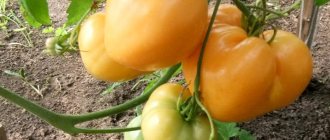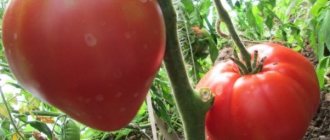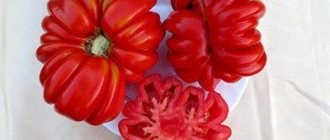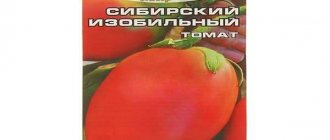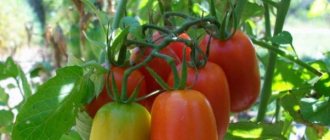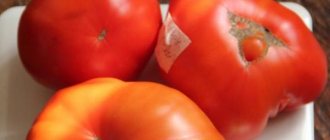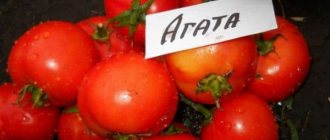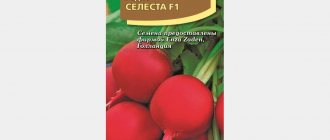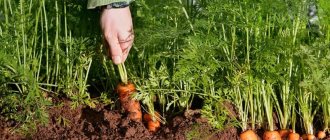History of the appearance of the variety
The Golden Fleece tomato is the result of breeding work by agricultural specialists; the variety was bred at the very end of the last century and submitted for inclusion in the State Register of Agricultural Achievements of Russia.
After several years of variety testing at experimental sites, in 2008 the Golden Fleece tomato was included in the Russian State Register.
According to the description of the originators of the variety, the Golden Fleece tomato can be grown in open ground or in any type of greenhouses and greenhouses. Breeders have zoned the Golden Fleece tomato for cultivation in most Russian regions.
Photo of tomato Golden Fleece
Growing rules
The choice of cultivation method is determined independently: a favorable climate and fertile soil are the basis for cultivating the Golden Fleece variety in open ground. In the northern regions, heated rooms are preferred.
Planting seedlings
Seed material is collected independently or purchased from producers. To do this, the ripe fruit is washed and patted down well, then left in this state for 2–3 days.
After the time has passed, the Golden Fleece tomato seeds are removed and washed in warm water. After this, they must be dried and packaged in a paper envelope. Store raw materials in a closet until spring.
A month before planting, they are calibrated, removing damaged seeds, and treated with the growth stimulator Immunocytophyte or Kornevin. To do this, place tomato seeds in the solution for 6 hours. At the end of the procedure, they are dried.
5 days before planting, the seed material of the Golden Fleece tomato is hardened. To do this, they are left on the bottom shelf of the refrigerator. Keep for 30 minutes, then increase the time to several hours.
The soil for planting is prepared in advance: humus, peat and soil are mixed in equal parts, and 0.5 tbsp is added. ash. Disinfect the soil with solutions of fungicides or potassium permanganate. Calcination of the soil in an oven is allowed (temperature up to 10 ºС). The prepared soil is distributed into containers: plastic dishes, special containers or peat pots.
One of the main requirements is the presence of drainage holes.
Planting seed material of the Golden Fleece variety is carried out as follows: it is placed in a container with soil and sprinkled with soil on top and moistened well. At the end of the procedure, the container is covered with film or glass.
Watering seedlings involves timely watering and loosening the soil. She needs to provide sufficient access to sunlight and prevent drafts.
Transfer
When choosing a location on a plot, it should be taken into account that the Golden Fleece tomato should not be planted in the place of predecessors such as pepper and other nightshades. The variety feels great in the garden where legumes, herbs and cucumbers previously grew.
Before transferring a tomato seedling into the ground, the soil is cleared of weeds and dug up. The optimal time for transplanting tomatoes is the end of May or the beginning of June.
Water is poured into the prepared hole and fertilizer containing nitrogen or phosphorus is added. The seedling is lowered into the hole and sprinkled with soil on top. If the danger of frost remains, the plant is covered with material.
Caring for the Golden Fleece variety consists of following the rules of agricultural technology: moistening the soil as it dries, loosening and timely weeding. It is recommended to hill up the bush.
Although this variety does not require staking, supports are built to avoid bending the bush to the ground under the weight of the tomatoes. For this purpose, trellises and metal structures are used.
Fertilizing is carried out three times during the growing season. For this, mullein or bird droppings are used (proportions 1:10). It is recommended not to neglect mineral fertilizers containing phosphorus and potassium.
Tomato Golden Fleece: variety description
The Golden Fleece tomato bushes are classified as a determinant type, but it would be more correct to consider them semi-determinant,
since when grown in greenhouse conditions,
the height of the shoots of this tomato can reach 0.9-1.1 m
.
And in garden beds in open ground, the Golden Fleece tomato grows more compact - up to 0.4-0.6 m, the diameter of the bushes can be 0.4-0.5 m
.
Due to their small size, these tomato bushes can be placed on one square in larger quantities than conventional varieties of tomatoes. It is noted that up to 7 Golden Fleece tomato bushes can be planted per 1 m2, which will develop and bear fruit normally. But at the same time , the bushes will need to be formed into no more than 2 stems and excess stepsons will need to be removed
. And when planting no more than 5 bushes on each square of area, you can skip the pinching procedure.
Therefore, each vegetable grower can choose his own method of growing the Golden Fleece tomato. Beginners usually try both methods and subsequently choose the most convenient for themselves.
Tomato Golden Fleece - video
On a note!
Tomatoes of the Golden Fleece variety are early ripening; it takes about a month from the moment the seed germinates until the product is harvested.
The shoots are erect, of medium thickness, quite powerful, and well leafy. The foliage is medium in size, typical tomato shape, slightly elongated, with sharp tips, dark emerald color.
The flowers are small, yellow in color, collected in racemes, up to 5-7 ovaries can form in each raceme
.
The fruits are shaped like an egg, but some fruits can grow oblong, similar in shape to the fruits of bell peppers. A sharp “nose” grows at the tips of many fruits. A small hole is clearly visible at the base.
Tomatoes of the Golden Fleece variety can weigh 90-110 g
. Ripening tomatoes are green in color; as they ripen, the color of the skin becomes rich orange. The skin is thin, smooth, with a characteristic shine. The fruit pulp is slightly compacted, with 2-3 seed chambers, the number of seeds in which is average.
The taste of the Golden Fleece tomato fruit is pleasant, sweetish, with a characteristic sourness. Many vegetable growers consider the fruits of this variety to be suitable only for canning, although taste is a personal matter for everyone.
Ripe tomatoes are not prone to cracking and can easily withstand transportation over different distances without losing their positive qualities.
Also, the harvested crop is perfectly stored for a long time in appropriate conditions.
Description and characteristics of the variety
The plant is semi-determinate, medium-sized, in open ground height 45-60 cm, in greenhouses up to 1.2 meters. The tomato is early ripening, the first fruits ripen 90-95 days after germination. The bush is stocky, produces an average number of stepsons, but it has to be formed only when the planting is dense. It falls under the weight of the fruit, so a garter is needed. The foliage is numerous, tomato-type, dark green.
The inflorescences are simple, the first one is formed after 5-7 leaves. 3-5 tomatoes are tied in a brush. Fruits during the summer period. The fruits are medium-sized, plum-shaped. The skin is strong, does not crack, the color is uniform, orange. The pulp is dense, yellow-orange, the seed chambers are medium, there are a lot of seeds and liquid.
Area of application of fruits
The ripe fruits of this variety are ideal for whole-fruit canning, and in combination with red and yellow tomatoes they look very beautiful in jars.
And the taste of the Golden Fleece tomato only improves during the pickling process.
. It should also be noted that the skin of these fruits does not crack during heat treatment.
Tomato juice from the fruits of the Golden Fleece tomato variety is tasty and original in color.
Ripe tomatoes of this variety add a pleasant taste to vegetable salads and are used to decorate dishes and snacks.
Diseases and pests
The originators of the variety claim that the Golden Fleece tomato has good resistance to most diseases
, characteristic of other tomato varieties.
Of the pests, the bushes of this tomato are most often damaged by aphids or spider mites.
, which can be fought with folk remedies. And in advanced cases, treat the vegetative mass with a solution of appropriate insecticides.
Interesting article:
What to do if the leaves of tomatoes in a greenhouse dry out and turn yellow
Positive qualities of the variety
Vegetable growers consider the main advantages of the Golden Fleece tomato variety to be:
- do not require special care during the growing process, including the bushes do not require pinching and staking of shoots;
- resistance to most diseases;
- The Golden Fleece tomato is early, ripe fruits can be harvested within 3 months after sowing the seeds;
- original and attractive appearance of ripe tomatoes;
- since this tomato is not a hybrid, seeds can be collected from its fruits for subsequent planting;
- the crop can be transported to any distance and stored in appropriate conditions for a long time;
- Up to 7-8 plants can be planted on one square.
But the variety also has a number of disadvantages:
- A not too large harvest of ripe fruits is harvested from one bush;
- Tomatoes have a taste that not everyone likes.
Pros and cons of the variety
This type of culture has some advantages and disadvantages. Therefore, they need to be studied in advance, which will allow you to finally make a decision to grow the Golden Fleece on your site.
For long-term storage of tomatoes, ensure a temperature of + 15 degrees
pros
- early ripening;
- excellent presentation;
- easy to transport;
- does not require formation;
- versatility of use;
- unpretentious to care;
- has increased resistance to pests.
Minuses
- when plantings are dense, it requires pinching;
- to preserve the presentation, it is necessary to tie up the bushes;
- The taste of the fruit is average.
Planting and growing
It is recommended to grow the Golden Fleece tomato in seedlings, and seeds should be sown for seedlings in the first ten days of April
.
Seedlings are planted in a permanent place at the age of 2 months.
– depending on the climatic conditions of the growing region from the last ten days of May to the first ten days of June. Adult seedlings can be planted in film greenhouses and greenhouses from the beginning of May.
Growing tomatoes using intensive technology - video
Planting and caring for seedlings is standard. It is necessary to water the plants on time, apply a couple of fertilizings with nitrogen fertilizers, and at the stage of two true leaves, pick the seedlings into separate cups.
A couple of weeks before transplanting seedlings into beds, you should begin hardening off the plants.
– take them outside for a short time in the first days, gradually increasing the time the seedlings spend in the fresh air.
Up to 7 tomato bushes should be planted on one square of area.
Features of cultivation
The species must be grown in seedlings. Wide containers with a height of 10 cm should be prepared in advance. They should have drainage holes to remove excess water. You also need to prepare a nutrient substrate:
- 2 hours of turf;
- 1 tsp peat;
- 1 hour humus;
- 1 tsp sand.
Immediately before planting, water the soil with a bright pink solution of potassium permanganate to disinfect it.
By the time Golden Fleece tomato seedlings are planted in a permanent place, the age of the seedlings should be 55 days, so sowing for further cultivation in a greenhouse should be carried out in the first ten days of March, and in unprotected soil - in early April. Before planting, treat the seeds in Zircon, which will increase plant immunity and improve germination.
Landing procedure:
- Fill the containers with soil, water well and wait until the moisture is absorbed.
- Compact from above, level the surface.
- Place the seeds at a distance of 1.5-2 cm.
- Sprinkle them with substrate - 0.5-0.7 cm.
The seedlings should be additionally moistened with a spray bottle.
After this, cover the containers with film and ensure they are kept at a temperature of +25 degrees. When friendly sprouts appear, which happens on the fifth day, move the containers to the windowsill and lower the maintenance regime to +18 degrees. In such conditions, it is necessary to keep the seedlings for seven days, which will allow them to grow roots.
Important! At the initial stage, you need to provide the seedlings with 12 hours of daylight, so in the evening you should additionally turn on the lamps.
When two true leaves appear, the plants must be planted in separate containers. And 10 days after that, feed with chicken manure 1:15.
Tomatoes should be planted in a permanent place in a greenhouse at the beginning of May, and in open ground at the end of this month, when the threat of return frosts has passed. Seedlings should have 5-7 true leaves and one flowering raceme.
Plants must be placed in groups of 5-7 pieces. per 1 sq. m. When transplanting, deepen the seedlings to the first leaves, which will strengthen the root system.
The Golden Fleece variety is undemanding to care. Watering the seedlings should be done as the top layer of soil dries. Also a prerequisite is the application of fertilizers. The first time fertilizing should be done 10 days after planting, when the plants get used to the new conditions and begin to grow. During this period, you can use organic matter, namely mullein 1:10 and chicken manure 1:15 or urea 30 g per 10 liters of water.
The second and third time, tomatoes need to be fed during flowering and ovary. Superphosphate (30 g) and potassium sulfate (15 g) should be applied to a bucket of water. This will speed up the ripening of tomatoes and improve their taste.
Further care for Golden Fleece tomatoes
After transplanting the plants to a permanent location, further care consists of maintaining the irrigation regime, applying fertilizers, mulching the soil and tying up the bushes if necessary.
Yellow tomatoes:
The best varieties of yellow tomatoes
Irrigation regime
Growing Golden Fleece tomato bushes require regular watering - the soil in the beds must be constantly moist. Watering is carried out at the root with warm, settled water in the evening hours. You need to make sure that drops of moisture do not fall on the foliage and stems.
After watering, it is recommended to loosen the soil and simultaneously remove all weeds.
. To retain moisture in the soil longer, it is recommended to mulch it with a layer of straw or cut grass.
If the shoots begin to fall to the ground under the weight of ripening fruits, they should be tied to strong supports. Otherwise, the fruits may begin to rot when they come into contact with the soil.
Feeding
During the growing period, Golden Fleece tomatoes should be fed several times with organic matter and mineral fertilizers.
For organic matter, it is best to use slurry or chicken manure solution.
. It is also good to use greenfinch infusion.
During the period of active fruit ripening, it is recommended to add superphosphate and potassium salt to the beds
– these fertilizers improve the taste of tomato fruits and promote the development of the root system.
Growing rules
The choice of cultivation method is determined independently: a favorable climate and fertile soil are the basis for cultivating the Golden Fleece variety in open ground. In the northern regions, heated rooms are preferred.
Planting seedlings
Seed material is collected independently or purchased from producers. To do this, the ripe fruit is washed and patted down well, then left in this state for 2–3 days.
After the time has passed, the Golden Fleece tomato seeds are removed and washed in warm water. After this, they must be dried and packaged in a paper envelope. Store raw materials in a closet until spring.
A month before planting, they are calibrated, removing damaged seeds, and treated with the growth stimulator Immunocytophyte or Kornevin. To do this, place tomato seeds in the solution for 6 hours. At the end of the procedure, they are dried.
5 days before planting, the seed material of the Golden Fleece tomato is hardened. To do this, they are left on the bottom shelf of the refrigerator. Keep for 30 minutes, then increase the time to several hours.
Important! At the end of the hardening procedure, the seeds must be stored in a warm room. The soil for planting is prepared in advance: humus, peat and soil are mixed in equal parts, add 0.5 tbsp.
ash. Disinfect the soil with solutions of fungicides or potassium permanganate. Calcination of the soil in an oven is allowed (temperature up to 10 ºС). The prepared soil is distributed into containers: plastic dishes, special containers or peat pots
The soil for planting is prepared in advance: humus, peat and soil are mixed in equal parts, and 0.5 tbsp is added. ash. Disinfect the soil with solutions of fungicides or potassium permanganate. Calcination of the soil in an oven is allowed (temperature up to 10 ºС). The prepared soil is distributed into containers: plastic dishes, special containers or peat pots.
One of the main requirements is the presence of drainage holes.
Planting seed material of the Golden Fleece variety is carried out as follows: it is placed in a container with soil and sprinkled with soil on top and moistened well. At the end of the procedure, the container is covered with film or glass.
Important! The optimal time for planting the Golden Fleece tomato is mid-March and early April. The region and climate characteristics are taken into account
Watering seedlings involves timely watering and loosening the soil. She needs to provide sufficient access to sunlight and prevent drafts.
Transfer
When choosing a location on a plot, it should be taken into account that the Golden Fleece tomato should not be planted in the place of predecessors such as pepper and other nightshades. The variety feels great in the garden where legumes, herbs and cucumbers previously grew.
Before transferring a tomato seedling into the ground, the soil is cleared of weeds and dug up. The optimal time for transplanting tomatoes is the end of May or the beginning of June.
Important! Planting scheme: leaves 70 cm between rows and 35 cm between seedlings. Water is poured into the prepared hole and fertilizer containing nitrogen or phosphorus is added.
The seedling is lowered into the hole and sprinkled with soil on top. If the danger of frost remains, the plant is covered with material
Water is poured into the prepared hole and fertilizer containing nitrogen or phosphorus is added. The seedling is lowered into the hole and sprinkled with soil on top. If the danger of frost remains, the plant is covered with material.
Caring for the Golden Fleece variety consists of following the rules of agricultural technology: moistening the soil as it dries, loosening and timely weeding. It is recommended to hill up the bush.
Although this variety does not require staking, supports are built to avoid bending the bush to the ground under the weight of the tomatoes. For this purpose, trellises and metal structures are used.
Fertilizing is carried out three times during the growing season. For this, mullein or bird droppings are used (proportions 1:10). It is recommended not to neglect mineral fertilizers containing phosphorus and potassium.
Tomato Golden Fleece: reviews from those who planted
Olesya, 35 years old, Leningrad region: When buying vegetable seeds for planting in the spring, I bought a bag of Golden Fleece tomato from . I planted the plants in a greenhouse, the bushes grew up to a meter in height. And after 3 months I was already picking beautiful orange fruits. We used them for food and also made a lot of twists for the winter.
Tatyana, 29 years old, Kemerovo region: I accidentally planted bushes of this variety in a greenhouse, although I planned to grow it in open ground. The bushes have grown simply huge in height - up to 1.5 m. The taste of ripe fruits is ordinary, and quite pleasant in salads. Although the tomatoes, in my opinion, are not too large.
Alexandra, 50 years old, Moscow region: I have been growing the Golden Fleece tomato variety for the fifth season. It does not require special care, pinching and gartering, perhaps just a little. Small and larger fruits can ripen on one bush. To improve the yield, it is necessary to apply fertilizing to the bushes - organic matter and complex mineral fertilizers.
Lists of the best varieties of tomatoes always mention the Golden Fleece tomato, which is distinguished by its original coloring of fruits, early ripening of products, the possibility of whole-fruit canning of tomatoes and the preparation of delicious tomato juice.
Therefore, this tomato variety has become quite popular among the country’s vegetable growers; moreover, it can be grown in beds and in greenhouse conditions in most Russian regions.
Reviews
Alina, Ufa
Tomatoes are my favorite summer vegetable. It is not only healthy, but also always a decoration for salads. The “Golden Fleece” variety is very interesting for its original shape and color. It also has an excellent and rather unusual sweetish taste. It is easy to grow even for beginners, as it is very unpretentious. I recommend it for growing for beginning vegetable growers.
Marina, Omsk
I grow the “Golden Fleece” variety in my greenhouse. The bushes are compact and easy to care for; I think the advantage is that they do not require staking or pinching. For its size, the plant is very productive, the fruits are juicy and tasty. Gives good results after heavy feeding.
